Vinicio Coletti's Web Site
R/C Models - Modelli radiocomandati
Boat - Barca
 |
Here is the beginning of the story. In November 2001 I went to a big hardware store and bought five cheap
pieces of wood. I don't even know what kind of wood it is, but it's quite light. Each table is 50x10x1 cm. Ecco come ho iniziato a costruire la barca, nel novembre 2001: con 5 tavole di legno di 50x10x1 cm. Le ho comprate in un grosso negozio di bricolage e sono molto economiche. Non ho proprio idea di che tipo di legno si tratti, ma le ho scelte per la loro relativa leggerezza. |
| Three tables were only cut a bit along one border, to put them at the right inclination. I derived from the
other two tables the rear trapeze and the three triangles for the front. Tre tavole sono state lasciate praticamente intatte, con solo un taglio inclinato su un bordo per farle aderire perfettamente, e sono servite per il fondo e per i due lati. Dalle ultime due tavole ho ricavato il trapezio di poppa e tre triangoli per costruire la prua. |
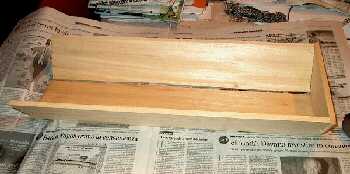 |
 |
To build the boat vessel I didn't use any metal parts, but only a good two-components glue, specific
for wood. You may argue that the vessel is not too idrodynamic, but, well, this boat was not designed
thinking to speed. Per mettere insieme le varie parti dello scafo non ho usato chiodi o viti, ma solo una buona colla a due componenti, pensata specificamente per il legno. Ho poi ricoperto le giunture con stucco da muratori, probabilmente superfluo. Come si vede, la forma non è certo idrodinamica, ma questa barca non è stata progettata per correre, ma solo per divertirsi un po'. |
| I installed then, after some months I left it apart, a 600BB cc motor, with joint and propeller axis.
The inclination of the axis is about 10 degrees and the propeller is plastic and it has a diameter of 4 cm. Dopo qualche mese di pausa, verso febbraio 2002 ho comperato ed installato il motore elettrico (un 600BB in corrente continua), completo di giunto cardanico, asse elica ed un'elica di 4 cm di diametro. Una barretta metallica mantiene il motore inclinato di circa 10 gradi. Il motore è fissato alla barretta con una fascetta metallica usata per i tubi del gas. |
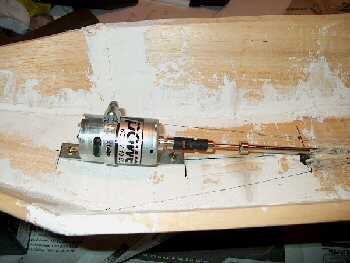 |
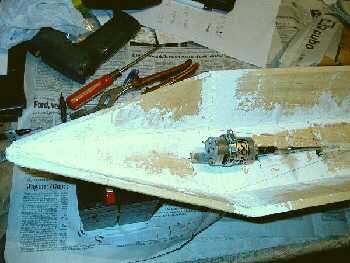 |
This is another view of the electric motor and the frontal part of the boat. Questa è un'altra prospettiva della prua della barca, con il motore installato all'interno. Ho deciso di installare il motore, cosa che ha comportato forare il fondo, prima di procedere alla verniciatura. |
| This is a bottom view of the propeller and the axis. Since the 600BB motor is directly connected to
the propeller axis, it must rotate quite quickly, thus I choosed a two-blades propeller. I am not sure
this reasonment is correct... Questo è il fondo della barca, con l'elica e il suo asse. L'elica è del tipo a due lame, per ridurre la resistenza e usarla ad un regime di rotazione più alto, per il fatto che il motore è collegato direttamente alla propulsione, senza riduzione del numero dei giri. Comunque, non sono del tutto sicuro che il ragionamento sia giusto e forse proverò anche un'elica a maggiore presa sull'acqua. |
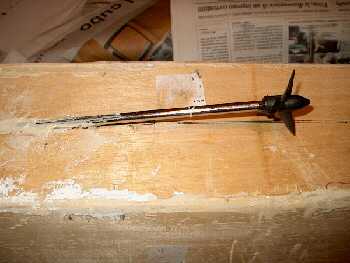 |
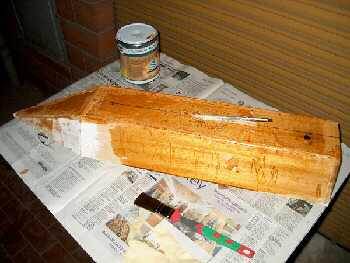 |
In June 2002 I realized that if I wouldn't work at the boat, it will not sail during summer holidays, so I bought
the colors and I begun painting. Arrivati a giugno del 2002, mi ricordai che se non avessi ripreso a lavorare sulla barca, difficilmente avrei potuto provarla durante le vacanze estive. Ho così aquistato due tipi diversi di vernice ed iniziato a dipingere la barca. |
| The first kind of paint colors the wood, so that it looks much better, and protects it against
the infiltration of water. I put three layers of this painting on the boat. Il primo tipo di vernice colora il legno, facendolo sembrare molto migliore, e lo protegge dalle infiltrazioni di acqua nei pori. Per dare il giusto colore e proteggere adeguatamente, ho steso tre mani di questa vernice sulla barca. |
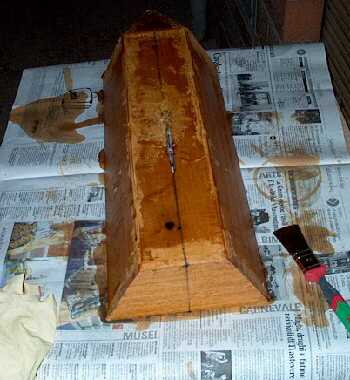 |
 |
The second paint is named flatting and is a water repellent. I put two layers of it
on the boat. Il secondo tipo di vernice è chiamata flatting e serve a rendere impermeabile il legno. Ho steso due mani di flatting, che oltretutto rende lucido il legno, per avere uno scafo ben resistente all'acqua. Nella foto è evidente la differenza tra zona dipinta e zona grezza. |
| At the end I tested the boat in my bathroom, just to see if it really didn't sink...
It was ok! I estimated a volume of about 5 dm3, so the weight of the boat must never go
over 5 kg. Actually, to have a good navigation, I decided not to go over 2,5 kg, all included. Alla fine ho provato in acqua per la prima volta la barca, nella vasca da bagno, per vedere se galleggiava bene. Andava perfettamente! Il volume della barca è un po' superiore ai 5 dm3 e quindi il peso complessivo non deve mai superare i 5 kg. Naturalmente, per avere una linea di galleggiamento non troppo alta, è bene avere un peso molto più basso e quindi ho pianificato un peso di circa 2,5 kg, per la barca completa di tutto l'equipaggiamento. |
 |
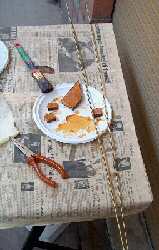 |
In July there was still a lot of work to do: I had to make and install the rudder and also make the
controller card for the motor, because I decided not to buy a commercial controller. I cut the rudder from
the same wood used from the vessel and painted it the same way. A metallic bar and pipe made the rudder axis
and I cut them to the right length. Arrivati a luglio, c'erano ancora molte cose da fare: innanzitutto il timone e poi la scheda per il controllo del motore, visto che avevo deciso di non comprare un controller commerciale (altrimenti, come ci si diverte?). Per il timone ho usato lo stesso legno della barca, dipinto nello stesso modo, e per l'asse del timone ho tagliato alla giusta lunghezza un tubo ed una barretta, entrambi di ottone. |
| Here is an external view of the rudder. To drive it I used the servo I found included in the Futaba
R/C transmitter package. Unfortunately, during one of the tests of the motor controller I inverted
the power cables and the servo burned in a second. I had to buy another one. The controller survived,
because I put a protection diode on it. Ben visibile nella foto il timone della barca. Per muoverlo ho installato il servocomando trovato nella confezione del trasmettitore Futaba, che però ho distrutto per errore quando ho inavvertitamente invertito la tensione di alimentazione durante una delle prove del motore. Ho così dovuto acquistare un secondo servocomando, di prestazioni simili. La scheda controller non ha invece subito danni, perché ha un diodo di protezione. |
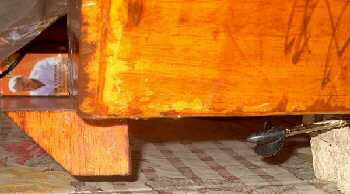 |
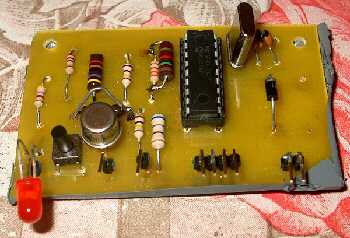 |
This is the motor speed controller card. It is on a pcb and is based on the Microchip PIC16F84A
microcontroller and few other components. Look here
for a detailed description of the card. Questa è la scheda che controlla la velocità del motore, realizzata su circuito stampato. E' basata sul microcontrollore Microchip PIC16F84A e pochi altri componenti. Guarda qui per una descrizione dettagliata del circuito. |
| This is the rear part of the boat. You can the the lead acid battery (6 V, 4 Ah), the rudder bar,
the servo, the R/C receiver (Futaba, 5 channels, 40 MHz) and the motor controller card. Questa è la poppa della barca, con l'accumulatore al piombo (6 V, 4 Ah), l'asse che muove il timone, il servocomando, il ricevitore per radiocomando (Futaba, 5 canali, banda 40 MHz) e la scheda controllo del motore. |
 |
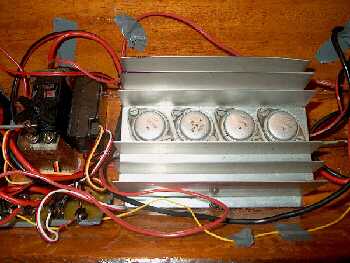 |
Here we see the power transistor module (4 x 2N3055 on a dissipating module). They are connected in
a Darlington configuration, with the first one driving the other three in parallel. This permits a steady
motor current of about 15 A or more and peaks of 45 A (about 270 Watt). Possiamo qui vedere il modulo di potenza, con 4 transistor 2N3055 montati su un dissipatore. I transistor sono in configurazione Darlington, con il primo che pilota gli altri 3 in parallelo. Ciò consente una corrente di almeno 15 A continui e 45 A di picco (circa 270 Watt). |
| Here you can see the motor and the two relays. I wanted to
use a single 30 A x 2 relay but I found only these one, that are
10 A x 3. So I put two of them, with the three switches put in
parallel. They are used to invert the motion direction, forward
or reverse. Although the reverse is barely used, it can be vital in
some situations (and is also a good brake). Qui si può vedere il motore ed i due relay da 30 A x 3 ognuno. Avrei voluto usare un singolo relay da 30 A a due scambi, ma è difficile trovarli così, alimentati a soli 6 Volt. Così ho trovato questi due ed ho connesso tutti gli scambi in parallelo, così da poter sopportare 30 A continui. Essi sono usati per commutare tra marcia avanti e indietro. La retromarcia è usata di rado, ma può essere molto importante in certe situazioni (ed è anche un ottimo freno). |
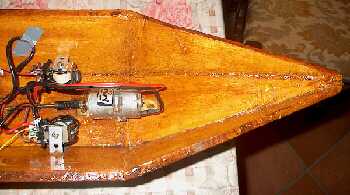 |
 |
Here is a total view of the boat, with all components and
ready to go. The coverage is made with balsa wood packed with
oven paper. It is a temporary solution, because I think I will
paint the balsa the same color of the boat. Ecco una vista dall'alto della barca, con tutti i componenti installati e pronta alla navigazione. Lo scafo è ricoperto con legno di balsa avvolto in carta trasparente da forno. Si tratta però di una soluzione temporanea, perché penso di dipingere la balsa con le stesse vernici usate per la barca, così da renderla impermeabile. |
| The boat is now really ready to go! On the left side you
can see the Futaba R/C transmitter. The antenna is made
with the wire of the receiver put inside several plastic
pipes (those used for drinks!). Light and cheap. The coverage
was put in case some water enters the boat, but of course
has the problem to reduce the dissipation of the heat coming
from the motor and the transistors module. Some other solutions
may be tried in the future. Ora la barca è veramente pronta alla partenza! Sul lato sinistro è visibile il trasmettitore per pradiocomandi Futaba. L'antenna è fatta con il filo del ricevitore fatto passare dentro alcune cannucce per bibite. Soluzione leggera ed economica. La copertura dello scafo, oltre che per ragioni estetiche, è stata pensata per evitare l'eventuale ingresso di acqua nello scafo, ma ha lo svantaggio di ridurre la dissipazione del calore proveniente dal motore e dal modulo a transistor. Visto che la barca è molto stabile in acqua, più di quanto pensassi, forse in futuro penserò ad una soluzione diversa. |
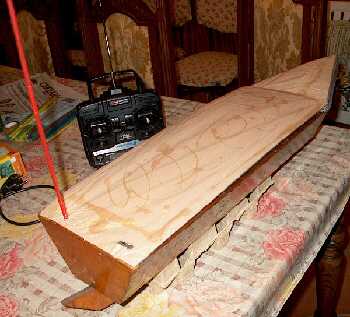 |
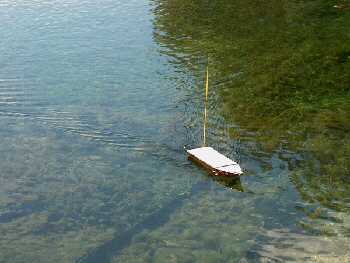 |
Here is the boat sailing at a very slow speed in a lake,
not too far from the shore. Here ther antenna is yellow pipes :-)
The first time the speed was actually limited because the motor axis was
not fixed well to the motor. Tightening some screws fixed the problem.
Qui la barca sta navigando molto lentamente vicino alla riva di un lago, con l'antenna fatta di cannucce gialle :-) Al primo tentativo in effetti la velocità della barca era limitata dall'asse motore fissato non molto bene. Ma è bastato stringere bene una vite per risolvere il problema. |
R/C Models
Create your counter